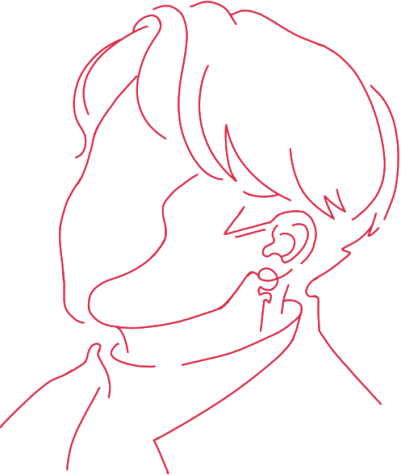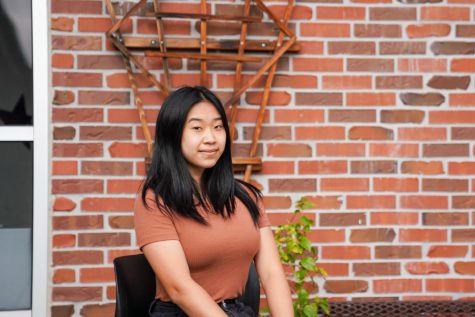The importance of proper representation
The misrepresentation of Asian communities is damaging
An Asian woman phasing into a sketch of herself, representing a loss of identity. Illustration | Sophia Ma
September 19, 2020
When thinking of iconic Asian works, many reference K-pop, Disney’s “Mulan” (1998), Bollywood and other commonly perceived aspects of Asian culture. Yet, V-pop (Vietnamese-pop) has little traction and pales in comparison to other Asian music genres in terms of popularity. While it has its own audience, it is rare to see a Vietnamese song gain popularity in America, and on a smaller scale, their culture does not have much acknowledgement within the MVHS community. Not as many people know of it, as it isn’t as “trendy” and doesn’t have as large of a following.
There is a lack of equal representation, as not all Asian entertainment outlets are as popular, and having just one culture in the spotlight is not nearly enough for the many others to be recognized. For example, many people are not aware that there are multiple dialects within languages. To name a few, India has a plethora of dialects, and China has one for almost every province. These are small but basic pieces of information that everyone should be aware of, especially if they are not from that region. Knowing these details gives concrete reasons to not believe that one culture is the same or too similar to another, and in turn help prevent myths about a culture.

There has been a gradual increase of Asian representation in the media. For example, in the past couple of decades, Korean culture has become prevalent internationally. Starting in the early 2000s, K-pop, K-dramas and other creative works of the Korean entertainment industry began gaining popularity. With K-pop groups like BTS and Blackpink gaining huge followings of over 100 million fans across social media platforms, appreciation for and the influence of Korean music has become apparent, but this is not the case for most other Asian groups.
In the case of Korean culture, we shouldn’t have to be spoon fed entertainment to understand mere snippets of a culture; it should be something that we actively seek out in order to educate ourselves. Relying on the success of a country’s entertainment industry to learn about their culture leaves room for misinterpretation and overgeneralization.
This is not limited to just entertainment, as the same can be said about other pieces of Asian culture. It seems as though the “bigger,” more standout cultures receive the spotlight, while others are sidelined and rarely appreciated. Asians get grouped together, muddling the distinct cultures into one of stereotypes, where they are expected to be able to do martial arts, be extremely smart or grow up to be a doctor or engineer.
The assumption that diversity in race is dependent on the few major racial groups fails to acknowledge the niceties within each race. According to Prep Scholar, MVHS’s student population is 78.3% Asian. However, within that percentage are individuals who identify with their respective cultures, many of which are lesser known. This Asian ethnic group includes at least 50 separate countries, each with their own traditions, beliefs and lifestyles. Yet, these distinct cultures are often grouped together in a label that is relatively distorted in its portrayal.
This implies that all Asians are the same, with little diversity. But Asia includes Taiwanese, Nepalian, Indonesian and many other ethnicities that do not get recognition. There is diversity within the group of Asian Americans, but simply labeling everyone as Asian doesn’t necessarily account for this. In general, Northeast Asians — Chinese, Japanese and Korean people to name a few — are the basis for stereotypes. However, these stereotypes have little regard for the large population of Southeast Asians, such as Indian, Singaporean and Malaysian people, who are often forgotten. It does not include everyone, creating an atmosphere where people feel dissociated with the idea of being “Asian.”

Recognizing comparatively smaller ethnic groups can ensure that people feel represented, and therefore allow us to realize that though many fit under the umbrella term of Asian, there is more to it than just that. According to a survey of 366 MVHS people, 240 respondents, which is 66%, agreed that the Asian demographic should be divided into smaller subgroups. This is an issue that directly affects our community, but fixing it is within our capability. So this single action could make a huge impact, allowing cultural differences to be acknowledged and honored.
With the resurge of movements like #BlackLivesMatter, attention has been put on the discriminant and racial inequalities in our community. So now more than ever, there must be recognition. This moment should be utilized to spread activism for awareness of existing issues in the area, one of them being the misrepresentation of racial groups, including Asians and Asian-Americans.
MVHS students are already actively advocating for change by sparking conversations about race and questioning the morality of situations that are normally taken for granted. This should continue and become more localized to our community. So instead of whitewashing ourselves and putting focus into the erasure of our culture, we should attempt to understand more about other Asian cultures to diversify and educate ourselves. Recognizing the nuances behind each culture, even on a small scale, will evoke momentous change.


















